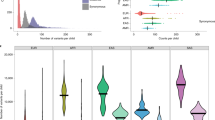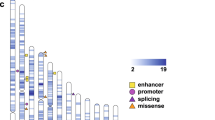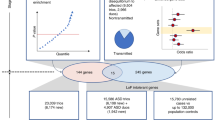Abstract
Several genome-wide screens have indicated the presence of an autism susceptibility locus within the distal long arm of chromosome 7 (7q). Mapping at 7q22 within this region is the candidate gene reelin (RELN). RELN encodes a signaling protein that plays a pivotal role in the migration of several neuronal cell types and in the development of neural connections. Given these neurodevelopmental functions, recent reports that RELN influences genetic risk for autism are of significant interest. The total data set consists of 218 Caucasian families collected by our group, 85 Caucasian families collected by AGRE, and 68 Caucasian families collected at Tufts University were tested for genetic association of RELN variants to autism. Markers included five single-nucleotide polymorphisms (SNPs) and a repeat in the 5′-untranslated region (5′-UTR). Tests for association in Duke and AGRE families were also performed on four additional SNPs in the genes PSMC2 and ORC5L, which flank RELN. Family-based association analyses (PDT, Geno-PDT, and FBAT) were used to test for association of single-locus markers and multilocus haplotypes with autism. The most significant association identified from this combined data set was for the 5′-UTR repeat (PDT P-value=0.002). These analyses show the potential of RELN as an important contributor to genetic risk in autism.
This is a preview of subscription content, access via your institution
Access options
Subscribe to this journal
Receive 12 print issues and online access
$259.00 per year
only $21.58 per issue
Buy this article
- Purchase on Springer Link
- Instant access to full article PDF
Prices may be subject to local taxes which are calculated during checkout



Similar content being viewed by others
References
Fombonne E . Epidemiological trends in rates of autism. Mol Psychiatry 2002; 7 (Suppl 2): S4–S6.
Yeargin-Allsopp M, Rice C, Karapurkar T, Doernberg N, Boyle C, Murphy C . Prevalence of autism in a US metropolitan area. J Am Med Assoc 2003; 289: 49–55.
Szatmari P, Jones MB, Zwaigenbaum L, MacLean JE . Genetics of autism: overview and new directions. J Autism Dev Disord 1998; 28: 351–368.
Folstein SE, Piven J . Etiology of autism: genetic influences. Pediatrics 1991; 87: 767–773.
Lotspeich LJ, Ciaranello RD . The neurobiology and genetics of infantile autism. Int Rev Neurobiol 1993; 35: 87–129.
Ritvo ER, Freeman BJ, Mason-Brothers A, Mo A, Ritvo AM . Concordance for the syndrome of autism in 40 pairs of afflicted twins. Am J Psychiatry 1985; 142: 74–77.
Smalley SL, Asarnow RF, Spence MA . Autism and genetics. A decade of research. Arch Gen Psychiatry 1988; 45: 953–961.
Bailey A, Le Couteur A, Gottesman I, Bolton P, Simonoff E, Yuzda E et al. Autism as a strongly genetic disorder: evidence from a British twin study. Psychol Med 1995; 25: 63–77.
International Molecular Genetic Study of Autism Consortium. A full genome screen for autism with evidence for linkage to a region on chromosome 7q. Hum Mol Genet 1998; 7: 571–578.
Pickles A, Bolton P, Macdonald H, Bailey A, Le Couteur A, Sim CH et al. Latent-class analysis of recurrence risks for complex phenotypes with selection and measurement error: a twin and family history study of autism. Am J Hum Genet 1995; 57: 717–726.
Caviness Jr VS . Patterns of cell and fiber distribution in the neocortex of the reeler mutant mouse. J Comp Neurol 1976; 170: 435–447.
D’Arcangelo G, Miao GG, Chen SC, Soares HD, Morgan JI, Curran T . A protein related to extracellular matrix proteins deleted in the mouse mutant reeler. Nature 1995; 374: 719–723.
Ogawa M, Miyata T, Nakajima K, Yagyu K, Seike M, Ikenaka K et al. The reeler gene-associated antigen on Cajal–Retzius neurons is a crucial molecule for laminar organization of cortical neurons. Neuron 1995; 14: 899–912.
Miyata T, Nakajima K, Mikoshiba K, Ogawa M . Regulation of Purkinje cell alignment by reelin as revealed with CR-50 antibody. J Neurosci 1997; 17: 3599–3609.
Nakajima K, Mikoshiba K, Miyata T, Kudo C, Ogawa M . Disruption of hippocampal development in vivo by CR-50 mAb against reelin. Proc Natl Acad Sci USA 1997; 94: 8196–8201.
Dulabon L, Olson EC, Taglienti MG, Eisenhuth S, McGrath B, Walsh CA et al. Reelin binds alpha3beta1 integrin and inhibits neuronal migration. Neuron 2000; 27: 33–44.
Yip JW, Yip YP, Nakajima K, Capriotti C . Reelin controls position of autonomic neurons in the spinal cord. Proc Natl Acad Sci USA 2000; 97: 8612–8616.
Ohshima T, Ogawa M, Veeranna, Hirasawa M, Longenecker G, Ishiguro K et al. Synergistic contributions of cyclin-dependant kinase 5/p35 and Reelin/Dab1 to the positioning of cortical neurons in the developing mouse brain. Proc Natl Acad Sci USA 2001; 98: 2764–2769.
Magdaleno S, Keshvara L, Curran T . Rescue of ataxia and preplate splitting by ectopic expression of reelin in reeler mice. Neuron 2002; 33: 573–586.
Impagnatiello F, Guidotti AR, Pesold C, Dwivedi Y, Caruncho H, Pisu MG et al. A decrease of reelin expression as a putative vulnerability factor in schizophrenia. Proc Natl Acad Sci USA 1998; 95: 15718–15723.
Guidotti A, Auta J, Davis JM, Giorgi-Gerevini V, Dwivedi Y, Grayson DR et al. Decrease in reelin and glutamic acid decarboxylase67 (GAD67) expression in schizophrenia and bipolar disorder: a postmortem brain study. Arch Gen Psychiatry 2000; 57: 1061–1069.
Fatemi SH, Stary JM, Egan EA . Reduced blood levels of reelin as a vulnerability factor in pathophysiology of autistic disorder. Cell Mol Neurobiol 2002; 22: 139–152.
Hutcheson HB, Bradford Y, Folstein SE, Gardiner MB, Santangelo SL, Sutcliffe JS et al. Defining the autism minimum candidate gene region on chromosome 7. Am J Med Genet 2003; 117B: 90–96.
International Molecular Genetic Study of Autism Consortium. A genomewide screen for autism: strong evidence for linkage to chromosomes 2q, 7q, and 16p. Am J Hum Genet 2001; 69: 570–581.
Shao Y, Wolpert CM, Raiford KL, Menold MM, Donnelly SL, Ravan SA et al. Genomic screen and follow-up analysis for autistic disorder. Am J Med Genet 2002; 114: 99–105.
Liu J, Nyholt DR, Magnussen P, Parano E, Pavone P, Geschwind D et al. A genomewide screen for autism susceptibility loci. Am J Hum Genet 2001; 69: 327–340.
Bradford Y, Haines J, Hutcheson H, Gardiner M, Braun T, Sheffield V et al. Incorporating language phenotypes strengthens evidence of linkage to autism. Am J Med Genet 2001; 105: 539–547.
Philippe A, Martinez M, Guilloud-Bataille M, Gillberg C, Rastam M, Sponheim E et al. Genome-wide scan for autism susceptibility genes. Paris Autism Research International Sibpair Study. Hum Mol Genet 1999; 8: 805–812.
Bradford Y, Haines J, Hutcheson H, Gardiner M, Braun T, Sheffield V et al. Incorporating language phenotypes strengthens evidence of linkage to autism. Am J Med Genet 2001; 105: 539–547.
Collaborative Linkage Study of Autism. An autosomal genomic screen for autism. Am J Med Genet 2001; 105: 609–615.
Persico AM, D’Agruma L, Maiorano N, Totaro A, Militerni R, Bravaccio C et al. Reelin gene alleles and haplotypes as a factor predisposing to autistic disorder. Mol Psychiatry 2001; 6: 150–159.
Zhang H, Liu X, Zhang C, Mundo E, Macciardi F, Grayson DR et al. Reelin gene alleles and susceptibility to autism spectrum disorders. Mol Psychiatry 2002; 7: 1012–1017.
Krebs MO, Betancur C, Leroy S, Bourdel MC, Gillberg C, Leboyer M . Absence of association between a polymorphic GGC repeat in the 5′ untranslated region of the reelin gene and autism. Mol Psychiatry 2002; 7: 801–804.
Bonora E, Beyer KS, Lamb JA, Parr JR, Klauck SM, Benner A et al. Analysis of reelin as a candidate gene for autism. Mol Psychiatry 2003; 8: 885–892.
Devlin B, Bennett P, Dawson G, Figlewicz DA, Grigorenko EL, McMahon W et al. Alleles of a reelin CGG repeat do not convey liability to autism in a sample from the CPEA network. Am J Med Genet 2004; 126B: 46–50.
Li J, Nguyen L, Gleason C, Lotspeich L, Spiker D, Risch N et al. Lack of evidence for an association between WNT2 and RELN polymorphisms and autism. Am J Med Genet 2004; 126B: 51–57.
American Psychiatric Association. Diagnostic and Statistical Manual of Mental Disorders (DSM-IV). 1994.
Lord C, Rutter M, Le Couteur A . Autism Diagnostic Interview-Revised: a revised version of a diagnostic interview for caregivers of individuals with possible pervasive developmental disorders. J Autism Dev Disord 1994; 24: 659–685.
Lord C, Pickles A, McLennan J, Rutter M, Bregman J, Folstein S et al. Diagnosing autism: analyses of data from the Autism Diagnostic Interview. J Autism Dev Disord 1997; 27: 501–517.
Sparrow SS, Balla D, Cicchetti D . Vineland Adaptive Behavior Scales, Interview Edition. American Guidance Service: Circle Pines, NM, 1984.
Vance JM . The collection of biological samples for DNA analysis. In: Haines JL, Pericak-Vance MA (eds). Approaches to Gene Mapping in Complex Human Diseases. Wiley-Liss: New York, 1998, pp 201–211.
Rimmler J, McDowell JG, Slotterback BD, Haynes CS, Menold MM, Rogala A et al. Development of a data coordinating center (DCC): data quality control for complex disease studies. Am J Hum Genet 1998; 63: 240.
Haynes C, Speer MC, Peedin M, Roses AD, Haines JL, Vance JM et al. PEDIGENE: a comprehensive data management system to facilitate efficient and rapid disease gene mapping. Am J Hum Genet 1995; 57: A193.
Eggerding FA, Iovannisci DM, Brinson E, Grossman P, Winn-Deen ES . Fluorescence-based oligonucleotide ligation assay for analysis of cystic fibrosis transmembrane conductance regulator gene mutations. Hum Mutat 1995; 5: 153–165.
Martin ER, Scott WK, Nance MA, Watts RL, Hubble JP, Koller WC et al. Association of single-nucleotide polymorphisms of the tau gene with late-onset Parkinson disease. J Am Med Assoc 2001; 286: 2245–2250.
Livak KJ . Allelic discrimination using fluorogenic probes and the 5′ nuclease assay. Genet Anal 1999; 14: 143–149.
O’Connell JR, Weeks DE . PedCheck: a program for identification of genotype incompatibilities in linkage analysis. Am J Hum Genet 1998; 63: 259–266.
Sobel E, Lange K . Descent graphs in pedigree analysis: applications to haplotyping, location scores and marker-sharing statistics. Am J Hum Genet 1996; 58: 1323–1337.
Zaykin D, Zhivotovsky L, Weir BS . Exact tests for association between alleles at arbitrary numbers of loci. Genetica 1995; 96: 169–178.
Lewontin RC . The interaction of selection and linkage. I. General considerations; heterotic models. Genetics 1964; 49: 49–67.
Weir BS . Genetic data analysis. II. Methods for discrete population genetic data. Sinaur Associates: Sunderland, MA, 1996.
Abecasis GR, Cookson WO . GOLD—graphical overview of linkage disequilibrium. BioInformatics 2000; 16: 182–183.
Martin ER, Monks SA, Warren LL, Kaplan NL . A test for linkage and association in general pedigrees: the pedigree disequilibrium test. Am J Hum Genet 2000; 67: 146–154.
Martin ER, Bass MP, Kaplan NL . Correcting for a potential bias in the pedigree disequilibrium test. Am J Hum Gen 2001; 68: 1065–1067.
Martin ER, Bass MP, Gilbert JR, Pericak-Vance MA, Hauser ER . Genotype-based association test for general pedigrees: the genotype-PDT. Genet Epidemiol 2003; 25: 203–213.
Rabinowitz D, Laird N . A unified approach to adjusting association tests for population admixture with arbitrary pedigree structure and arbitrary missing marker information. Hum Hered 2000; 50: 211–223.
Horvath S, Xu X, Lake SL, Silverman EK, Weiss ST, Laird NM . Family-based tests for associating haplotypes with general phenotype data: application to asthma genetics. Genet Epidemiol 2004; 26: 61–69.
Acknowledgements
We wish to thank the patients with autism and family members who agreed to participate in this study. We gratefully acknowledge the resources provided by the Autism Genetic Resource Exchange (AGRE) Consortium and the participating AGRE families. The Autism Genetic Resource Exchange is a program of Cure Autism Now. We also thank the personnel of the Center for Human Genetics at Duke University Medical Center, who provided a great deal of support and input on this project. This research was supported in part by National Institutes of Health (NIH) program project grant NS26630, NIH R01 grants HD36701 and NS36768, and by the National Alliance of Autism Research (NAAR) through a gift from Audrey Flack and H Robert Marcus. The research conducted in this study complies with current US laws.
Author information
Authors and Affiliations
Corresponding author
Rights and permissions
About this article
Cite this article
Skaar, D., Shao, Y., Haines, J. et al. Analysis of the RELN gene as a genetic risk factor for autism. Mol Psychiatry 10, 563–571 (2005). https://doi.org/10.1038/sj.mp.4001614
Received:
Revised:
Accepted:
Published:
Issue Date:
DOI: https://doi.org/10.1038/sj.mp.4001614
Keywords
This article is cited by
-
Investigation of Genetic Polymorphism in Autism Spectrum Disorder: a Pathogenesis of the Neurodevelopmental Disorder
Advances in Neurodevelopmental Disorders (2022)
-
An analytical method for the identification of cell type-specific disease gene modules
Journal of Translational Medicine (2021)
-
A systematic review of common genetic variation and biological pathways in autism spectrum disorder
BMC Neuroscience (2021)
-
Bio-collections in autism research
Molecular Autism (2017)
-
Modeling of Autism Using Organoid Technology
Molecular Neurobiology (2017)



